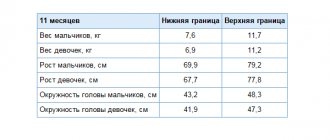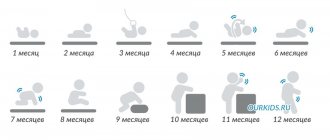Physical development
In infancy, a girl lags behind a boy in all respects. On average, a boy is 0.5 kg larger and 2-3 cm taller. The difference between peers of opposite sexes persists in the first year of life, and then disappears.
Norms of physical indicators for five-month-old children:
| Index | Meaning |
| Height | 64-66 cm |
| Weight | 6.9-7.5 kg |
| Head circumference | 41.5-42.5 cm |
| Chest circumference | 43-44 cm |
Physical abilities
Bones are more elastic and proportional than before. Thanks to this, tactile sensations become well developed. During this period, the digestive system has already adapted to food, so intestinal colic practically disappears. Children who, in addition to formula and breast milk, began to receive complementary foods, defecate no more than 1-2 times a day. The consistency of stool varies and depends on the type of feeding.
Saliva is produced abundantly due to the eruption of the first baby teeth, which can last up to a year or longer. At the same time, the gums swell, the temperature may rise and the secretion of mucus in the nose may increase.
What should a 5 month old baby be able to do?
By this age the child:
| Previously acquired physical skill that may become apparent at 5 months | New skill |
| Raises head while lying on stomach | Recognizes mother and loved ones |
| Wraps hand around mother's breast or bottle during feeding | Consciously follows objects disappearing from the field of vision with his gaze |
| Laughs and smiles in the game | Rolls over from stomach to side or back |
| Gulit | Grabs and holds toys tightly |
| Tries to rise up while lying on his stomach, leaning on his palms | Accepts objects from an adult's outstretched hand |
| He hums in a sing-song voice, uttering sounds that are new to him. | |
| Reacts to nursery rhymes and songs | |
| Looks at colorful patterns for a long time |
Physical abilities and reflexes
The child no longer lies quietly, but actively learns about his body and tests its capabilities. He not only balances while lying on his stomach, but also lifts his bent legs and arms up. Extending and pushing movements appear, preparing the fragile body for crawling. The baby already holds his head straight when in his arms or lying on his stomach. When lifted in his mother's arms, his head does not tilt back. By this time, the newborn's reflexes fade away.
Intellectual development of a child
The period from 4 to 6 months is called pseudospeech. Children pronounce sounds that are non-localized and extremely vague in articulation. They also distinguish their thumb from others and begin to actively use it in games.
Perception of the world
The eye muscles are fully formed, thanks to which the baby looks at everything around with pleasure and follows moving objects. He reacts emotionally to his own and strangers, greeting the former with a smile, and the latter with tears or genuine fear on his face.
The baby begins to distinguish voices, first of all distinguishing the mother’s voice from the general noise. It begins to respond to sounds, the source of which may be at a distance of 5-6 meters.
Daily routine, sleep and nutrition
The life of a 5-month-old child involves feeding 6 times a day, naps 2-3 times a day and 1-2 walks in the fresh air. Each family has its own daily routine, but you can use the following example as a guide:
| Time | Class |
| 6:00 | Climb |
| 6:00-7:30 | Hygiene procedures and feeding |
| 7:30-9:00 | Sleep after breakfast |
| 9:00-10:00 | Feeding |
| 10:00-12:30 | Walk or sleep |
| 12:30-14:00 | Feeding, games, gymnastics or other exercises |
| 14:00-16:30 | Walk or sleep |
| 16:30:17:30 | Feeding, touring the house, or listening to music |
| 17:30-19:30 | Dream |
| 19:30-20:00 | Feeding |
| 20:00-20:30 | Reading books out loud or playing sedentary games |
| 20:30-21:00 | Bathing and getting ready for bed |
| 21:00 | Sleep that can be interrupted by 1 feeding |
⠀
In addition to formula and breastfeeding, the baby can receive other foods. You should consult your pediatrician about introducing early complementary foods during a routine examination. The doctor recommends starting complementary feeding if the child’s weight is not normal, the child suffers from constipation and often spits up from liquid feeding. It is allowed to give vegetable and fruit purees, juices and cereals. These products are enough for up to six months.
5 months is the age when the baby can be introduced to:
- zucchini;
- cauliflower;
- broccoli;
- potatoes;
- green apple
Do not rush to give brightly colored vegetables and fruits. Allergies are often caused by carrots and pumpkin.
Increase the portion evenly, starting with ¼ teaspoon per day, then move to ½ teaspoon and increase complementary feeding to 100 g by the end of the 5th month.
It is better to serve a green apple baked rather than pureed. Use homemade puree or store-bought puree. If you cook yourself, use seasonal vegetables as much as possible. If you buy jars in a supermarket, pay attention to their expiration date.
Possible problems
Not all children develop normally.
The older children become, the more clearly one can notice deviations in physical and psycho-emotional terms. For example, neurological abnormalities may become noticeable at five months of age. Symptoms of deviations are as follows: the girl does not smile and closes her eyes too much. In this case, you need to visit a neurologist. A common problem for five-month-old children is diathesis.
It occurs in babies who have started feeding. This is the child’s body’s response to changes in nutrition. If diathesis is not treated, it can develop into an allergic reaction to a certain product. Girls at 5 months are very mobile, so they often get injured. It is important for parents not to leave them unattended.
When should you worry?
If a child is developmentally delayed, parents will notice movement disturbances, lack of interest in the world around them, and reactions to changes in colors or sounds. Monitor your baby carefully before sounding the alarm and running to the pediatrician. Spend more time with him to notice the slightest changes in his behavior.
You should be concerned when a five-month-old baby:
- does not pronounce simple syllables and consonants. His speech consists of drawn-out vowels. He does not try to pronounce new sounds, but continues to hum, as at 4 months;
- does not try to pull himself up or roll over from his back to his stomach when an adult helps him;
- does not turn around and does not change his face when a quiet conversation changes into emotional statements;
- does not tighten the fabric covering the eyes when lying on your back. Normally he should try to remove what is obstructing his vision;
- does not resist when they try to take a toy from him. Children at this age hold tightly and do not give up an object when it is taken out of their hands;
- cannot wrap his hands around a ball held out by an adult;
- does not show interest in new objects that appear in the field of vision. If there is a nondescript object in front of the baby, he should quickly switch when he sees a bright toy;
- does not follow his eyes with his mother moving around the room and looks at one point;
- can't hold his head up. It hangs when he is lifted by the handles from a lying position to a sitting position;
- cannot relax muscles on their own. Hypertonicity is corrected by gymnastics and therapeutic massage.
If you notice any abnormalities, you should consult your pediatrician.
Doctor Komarovsky's opinion on the development of five-month-old babies
What about the specialists? Turning to People's Doctor Evgeniy Komarovsky for advice on the development norms of five-month-old children, many mothers have repeatedly received a number of useful recommendations and explanations from him.
The doctor claims that at this age, babies should recognize their loved ones, distinguish their voices, take and hold toys, lean on their palms while lying on their stomachs, walk for a long time and increase their activity.
Evgeniy Olegovich advises not to lose common sense if the baby begins to master some skills later than his peers, arguing that by the age of 1 - 1.5 years there will be no trace of such differences.
How to help your child develop?
Give up the desire to raise a genius from the cradle and focus on the physical, sensory, emotional and speech development of your baby. Vary your daily routine with activities aimed at learning new skills. The peculiarity of all games is their simplicity and easy learning. It is not necessary to do all the exercises and games in one day. Do gymnastics with your baby every day. Watch the video with step-by-step instructions:
Physical development
An hour after feeding, place the baby on a fitball or large ball with his stomach or back, holding him by the hands. Slowly swing the ball from side to side, or moving in a circle. If there is no fitball, do passive gymnastics through stroking in a circular motion, rubbing or kneading the muscles.
A good exercise for strengthening the child’s muscle corset and maintaining the mother’s abs: lie on your back and place the baby on your stomach, resting your elbows on your legs, bent at the knees. Lift your shoulder blades off the floor and keep your shins parallel to the floor. Holding the child with your hands, swing from side to side. In the same position, you can perform crunches to pump up your abs.
Encourage crawling by imitating it with your baby every day. Place the baby on your stomach and your left hand under it. With your right hand, support your legs bent at the knees. Lift the child with your left hand and push him forward with your right. You can crawl a meter this way, the main thing is to repeat this exercise regularly.
In the fifth month of life, the baby sways from side to side on its stomach. Its movements are similar to swimming. It can be placed on a flat surface and surrounded on different sides with various toys. He will try to reach them, stretching his arms forward and trying to crawl to the place where the object is located.
Speech and fine motor skills
Stretch your fingers and hands, and also give a tour of the house, showing objects and describing their names, color, shape. Fill a fabric bag with buckwheat to stimulate the nerve endings on your fingertips.
Hang colorful pictures around the house or arrange books with 1 or 2 characters on them. Carry the child in your arms, stopping in front of them. After you name who is shown in the picture, take a couple of steps to the side and say the name of the drawn character again. A child can search with his eyes and turn back to find a previously seen hero.
Thinking
Choose a musical toy with buttons, a soft melody and moderate light. Use your baby's finger to alternately press different buttons, pausing for a few seconds so that he can notice the difference between the sounds.
The game "Peek-a-boo" will help predict the outcome of actions. Covering your face with your hands in front of the child, and then moving your hands to the side, say “ku-ku.” At first the child laughs, but as he grows up he stops reacting violently, because he already knows how it will all end.
Perception
The baby learns about the world by examining, touching, biting and licking various objects. Support him in this endeavor by making a sensory box from scrap materials. Take a basin, pan or cardboard box with high sides. Fill it with various cereals, pasta, raisins, nuts, buttons, scraps of various fabrics and other items. They should differ in shape, size and texture. Your child may spill or throw the contents of the sensory box overboard, so be prepared for some mess.
Create your first masterpieces with your baby. Lay oilcloth or newspapers on the floor so as not to stain it. Prepare a jar of watercolors and white sheets. Sit on the floor and place the child in front of you. Dip his finger in the paint and apply it to the paper. In addition to your finger, you can completely paint your palm and make your baby’s first prints as a keepsake. If he puts everything in his mouth, then you can use fruit or vegetable puree instead of paint. They won't be able to draw, but you will leave a few blots on the paper.
A five-month-old baby becomes more active in exploring the world. New skills are added to those already acquired. Complementary foods appear in the feeding, the amount of which increases by the 6th month. Baby development should be aimed at strengthening muscles and tactile sensations.
Child development through games and exercises
At this time, children begin to deliberately throw toys out of the stroller or crib, demanding that their mother pick them up. This is not just a whim, such a game is a way of understanding the world. The child makes observations and experiments: how long will the toy fall, where will it fall, and with what sound. In addition, in this way the baby may try to attract mother’s attention; it is extremely important for the child to receive as much communication as possible with loved ones.
When your baby reaches for a toy in your hands, try moving it a little further so your baby can try to catch it. Move it from place to place, stimulating your five-month-old baby to concentrate his attention and coordinate his movements.
Name the objects you have in your hands. Read fairy tales to him, be sure to tell him about what is drawn in the bright pictures. Explain what is around you. Enrich in every possible way the baby’s baggage of words and concepts about the world around him.
A 5-month-old baby is trying to control his actions; if the baby catches your hand or grabs an object, try to take it away from him. Let him make an effort to get the thing back. Be sure to give in to him, let the child experience the joy of his achievement. New toys for a five-month-old baby can be soft cubes or foam pillows.
These can be various geometric shapes: cylinder, cone, sphere, prism, cube. They should have colorful designs, all kinds of stripes. The baby can be placed on his stomach on one of these soft toys or placed on horseback. Place a pillow under his chest so he can roll on it. This way the baby will learn to understand the properties of objects. Small objects will allow you to develop fine motor skills. Let the child touch them, sort them out, move them from place to place, from hand to hand.
Exercises for babies 5 months:
- Bike. The child lies on his back. Grasp his shins so that your thumbs are on top. Gently bend your legs. Alternately bend and straighten them, as if your baby was pedaling a bicycle. Repeat this exercise 6-8 times.
- Easy steps. Place your baby on his back with his feet facing you. Lightly grab his ankles. Take turns pulling your legs towards you so that your foot slides along the surface. After the leg is fully straightened, return it to its original half-bent position. Do this 4-6 times.
- Crawl. Stimulate your baby's desire to crawl. To do this, place the baby on his stomach and place several bright toys at a short distance from him. It’s good if the child takes them out 4-5 times in one lesson. Very soon he will learn to crawl on his own.
- Fitball exercises. To develop the vestibular system, use a “Swiss” ball. With its help you can strengthen balance, back muscles and the overall tone of the baby.
- Gymnastics class. Pay attention daily to gymnastic exercises aimed at strengthening the back muscles and cervical spine. Dynamic spreading and crossing of the baby's arms at the chest, massage of the legs while lying on the tummy and back, rubbing, help relieve emotional stress and normalize the psyche. In addition, performing 10-15 minutes of active movements strengthens muscle tone and also promotes rapid learning to control your own body.










